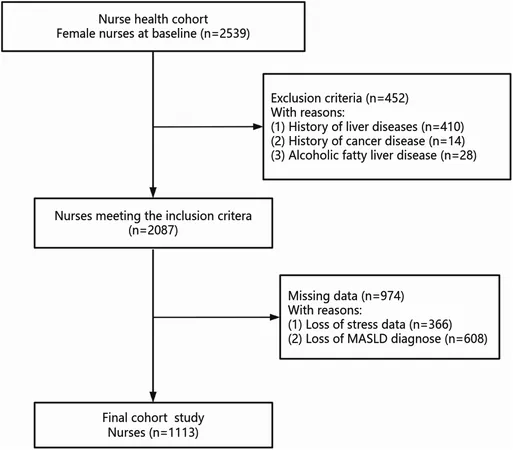
Alarming Link Between Occupational Stress and Rising Liver Disease in Female Nurses: A Must-Read Study!
2024-11-16
Author: Rajesh
Introduction
A new groundbreaking study reveals a shocking connection between occupational stress and metabolic dysfunction-associated steatotic liver disease (MASLD) in female nurses. This research underscores a burgeoning public health crisis as nurses, who are on the frontlines of healthcare, grapple with increasing stress levels that could jeopardize their health further.
Study Overview
Metabolic dysfunction-associated steatotic liver disease, previously known as non-alcoholic fatty liver disease, is becoming a leading cause of chronic liver issues globally, with high prevalence rates observed across various populations. Recent statistics indicate that globally, approximately 32.4% of people are affected, which is projected to rise, particularly in rapidly urbanizing regions like China. The new study, conducted from 2018 to 2024, investigates the influence of occupational stress on the onset of MASLD among 1,113 Chinese female nurses, revealing troubling findings that demand urgent attention.
Methodology
The study utilized the Chinese Nurse Job Stress Scale to gauge stress levels over four crucial time points. Through innovative statistical modeling, researchers identified three distinct occupational stress trajectories: moderate decreasing, moderate stable, and moderate increasing. Over the follow-up period, 256 of these nurses were diagnosed with incident MASLD, highlighting a significant trend that reveals a clear link between rising stress levels and the onset of liver disease.
Findings and Implications
Strikingly, nurses in the moderate increasing occupational stress group exhibited a staggering 3.14 times higher risk of developing MASLD compared to their peers in the moderate stable group. This alarming statistic calls attention to the critical need for stress management interventions and enhanced support systems for healthcare workers. With MASLD posing risks for severe complications such as cirrhosis and diabetes, addressing occupational stress within nursing can no longer be ignored.
The study also noted that despite variations in age and body mass index (BMI), the association between rising stress and MASLD remained potent. These results highlight an urgent need for comprehensive health strategies targeting the unique stresses faced by nurses—such as long hours, heavy workloads, and the emotional toll of patient care.
The Bigger Picture
While the prevalence of MASLD in China is lower than in Western countries, it is rising rapidly due to lifestyle changes and economic growth. Projections indicate that by 2030, China could see a staggering 314.58 million cases of MASLD—a 29.1% increase. These projections emphasize the urgency of addressing this issue.
Moreover, the study’s findings align with broader research, linking occupational stress with various health issues, including obesity, diabetes, and cardiovascular diseases. Such evidence confirms that addressing stress is not merely a personal matter but a public health priority that could potentially save lives.
Conclusion
This landmark study illuminates an essential but often overlooked factor in nurses' health: occupational stress. As we pave the way for future research, the implications of these findings call for systemic changes within healthcare environments to mitigate stress and its grave consequences on health.
A Call to Action
Healthcare organizations, policymakers, and society at large must collaborate to develop effective interventions to tackle this escalating crisis. Ignoring the profound impacts of occupational stress is no longer an option, especially when the health of those who care for the sick is at stake. It's imperative that we turn the tide on occupational stress among nurses—before it’s too late!
Stay tuned for further updates and insights into this pressing issue that touches the lives of millions.


 Brasil (PT)
Brasil (PT)
 Canada (EN)
Canada (EN)
 Chile (ES)
Chile (ES)
 España (ES)
España (ES)
 France (FR)
France (FR)
 Hong Kong (EN)
Hong Kong (EN)
 Italia (IT)
Italia (IT)
 日本 (JA)
日本 (JA)
 Magyarország (HU)
Magyarország (HU)
 Norge (NO)
Norge (NO)
 Polska (PL)
Polska (PL)
 Schweiz (DE)
Schweiz (DE)
 Singapore (EN)
Singapore (EN)
 Sverige (SV)
Sverige (SV)
 Suomi (FI)
Suomi (FI)
 Türkiye (TR)
Türkiye (TR)